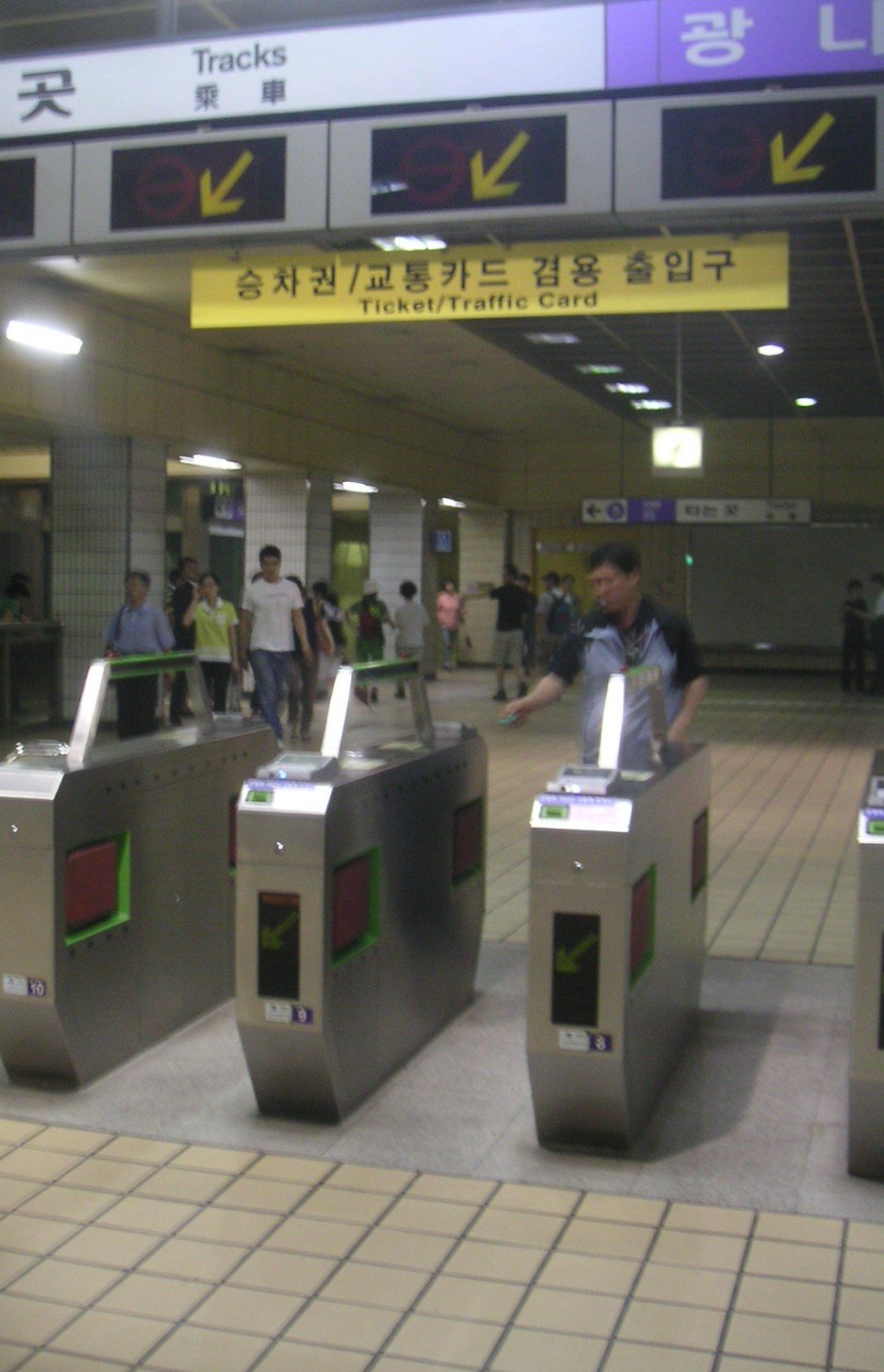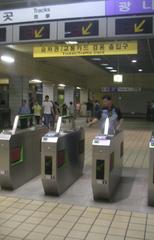
Gwangnaru Station Guide: Visiting Hours, Tickets, and Seoul Historical Sites
Date: 15/06/2025
Introduction: Gwangnaru Station’s Role in Seoul
Gwangnaru Station, situated in the lively Gwangjin-gu district of eastern Seoul, is more than a subway stop—it’s a gateway to the city’s layered past, natural beauty, and dynamic urban life. Nestled on Seoul Subway Line 5, Gwangnaru offers direct access to significant sites like Gwangnaru Hangang Park, the Amsa-dong Prehistoric Site, and Achasan Mountain. With modern facilities and a strategic location, the station welcomes both tourists and commuters, serving as a launchpad for exploring Seoul’s historic and cultural riches (Open Korea; Seoul Solution).
Historically, the Gwangnaru area has been a crucial crossing point on the Han River since ancient times. It played an important role during the Three Kingdoms period and the Joseon Dynasty, shaping Seoul’s development from a dynastic capital to a modern metropolis. Today, Gwangnaru Station stands as a testament to the city’s evolution, blending accessibility, community life, and a wealth of attractions (Seoul Metropolitan Government; Lonely Planet; KoreaToDo).
Quick Navigation
- Introduction to Gwangnaru Station
- Historical Evolution of the Area
- Gwangnaru Station: Visitor Information
- Top Nearby Attractions
- Getting There & Travel Tips
- Facilities, Layout, and Accessibility
- Exits & What’s Nearby
- Cultural Events and Community
- Safety, Security, and Cleanliness
- Gwangnaru Safety Experience Center
- Practical Tips & FAQs
- Essential Links and Sources
Historical Evolution of the Gwangnaru Area
Ancient and Dynastic Heritage
Gwangnaru’s roots reach back to the Three Kingdoms era, when the Han River provided a natural defense and a vital trade artery. The Joseon Dynasty later formalized the region’s urban layout, and the historic Gwangnaru ferry crossing connected the city’s eastern approaches to its core. This pivotal crossing fostered commerce and cultural exchange (Open Korea; Seoul Solution).
Modernization and Urban Expansion
During Japanese colonial rule in the early 20th century, new infrastructure—roads, bridges, and railways—was introduced, paving the way for the subway system and the integration of Gwangjin-gu into the expanding city (Open Korea).
Contemporary Growth and the Subway Era
Following the Korean War, Seoul’s rapid growth led to the launch of the subway system in the 1970s. Gwangnaru Station, opened in the mid-1990s on Line 5, now connects central Seoul to its vibrant eastern neighborhoods, supporting both urban mobility and local cultural life (Seoul Solution; Seoul Public Transportation; Wikipedia).
Gwangnaru Station: Visitor Information
Operating Hours
- First Train: ~5:30 AM
- Last Train: ~midnight
- Frequency: 4–6 minutes during peak, 7–10 minutes off-peak
Tickets
- Single-ride Tickets: Purchased at station machines
- T-money Card: Rechargeable card for subways/buses; available at convenience stores
- Tourist Pass (Climate Card): Unlimited rides for 1–5 days (In My Korea)
Accessibility
- Elevators, tactile paving, accessible restrooms
- Multilingual signage (Korean, English, Chinese, Japanese)
- Wide ticket gates
- Audio/visual announcements
Station Layout and Exits
- Platforms: 2
- Tracks: 2
- Exit 1: Achasan Mountain and Ecological Park (KoreaToDo)
- Exit 2: Walkerhill area and Cherry Blossom Road (Creatrip)
- Exit 3: Direct to Gwangnaru Hangang Park and Safety Experience Center
Top Nearby Attractions
Gwangnaru Hangang Park
- Features: Water source protection area, migratory birds, bike park, drone park, observatory
- Hours: 5:00 AM–10:00 PM
- Admission: Free
- Access: Short walk from Exit 3 (Seoul Metropolitan Government)
Amsa-dong Prehistoric Site
- Significance: Korea’s Neolithic settlements
- Admission: Check local listings for hours
Achasan Mountain and Ecological Park
- Hiking: Beginner-friendly trails (~2 km, 1–1.5 hours), fortress ruins
- Views: Panoramic city and river vistas
- Access: Bus 130/370 from Gwangnaru Station, or Exit 1 (KoreaToDo)
Walkerhill Hotels & Cherry Blossom Road
- Luxury hotels: Grand Walkerhill, Vista Walkerhill Seoul
- Casino: Paradise Casino (foreigners only, passport required)
- Access: Bus or taxi from Exit 2 (Walkerhill Hotels; Creatrip)
Facilities and Amenities
- Restrooms: Modern, accessible, with baby-changing stations
- Waiting Areas: Ample, climate-controlled seating
- Lockers: Coin-operated for all luggage sizes
- Convenience Stores: GS25, 7-Eleven, vending machines, ATMs
- Wi-Fi: Free throughout the station (Lonely Planet)
- Information: Staffed desks, multilingual digital kiosks
- Safety: CCTV, regular patrols, emergency alarms
Cleanliness, Security, and Maintenance
Seoul Metro upholds high standards of hygiene and safety. Stations are cleaned frequently, recycling is encouraged, and staff are trained to assist travelers, including those with disabilities.
Cultural Life and Community Events
- Hangang Summer Festival: Outdoor performances, drone light shows (KoreaToDo)
- Walkerhill Cherry Blossom Festival: Best in spring, ideal for photography
Local cafés, such as Café Naru near Gwangjang Middle School, offer a cozy glimpse into community life (Visit Seoul).
Gwangnaru Safety Experience Center: Essential Guide
Overview
The Gwangnaru Safety Experience Center, near Exit 3, is an interactive facility dedicated to disaster preparedness and safety education. Visitors can participate in earthquake, fire, and first aid simulations, making it both family-friendly and educational (Gwangnaru Safety Experience Center Official Website).
Hours & Admission
- Open: Tuesday–Sunday, 10:00 AM–6:00 PM (last entry 5:30 PM)
- Closed: Mondays & national holidays
- Admission: Free
- Reservations: Recommended for groups; English tours available upon request
Accessibility
- Wheelchair accessible, elevators, restrooms, breastfeeding rooms
- Staff assistance in English and Korean
Other Nearby Highlights
- Olympic Park: 24-hour outdoor access, museum open 10:00 AM–6:00 PM (Olympic Park)
- Gwangjin Library: 9:00 AM–10:00 PM, quiet reading and events (Gwangjin Library)
- Gwangjang Market: Authentic street food, accessible via Line 5 (Visit Korea - Gwangjang Market)
- Seoul Children’s Grand Park: Zoo, gardens, rides; Line 7 transfer (Seoul Children’s Grand Park)
- Cheonho-dong Shopping: Malls, cinemas, nightlife; one stop east
Practical Visitor Tips
- T-money Card: For convenient subway and bus rides
- Navigation Apps: Use Subway Korea or similar for routes and exit info
- Language: Multilingual signage; translation apps helpful in local eateries
- Travel Times: Avoid rush hour (7:30–9:00 AM, 6:00–7:30 PM)
- Luggage Storage: Use station lockers before hiking or sightseeing
- Seasonal Visits: Spring and autumn offer the best weather and events
Frequently Asked Questions (FAQs)
Q: What are Gwangnaru Station’s operating hours?
A: About 5:30 AM to midnight daily.
Q: Are the hiking trails at Achasan suitable for beginners?
A: Yes, the trails are gentle and family-friendly.
Q: Can I rent a bike near Gwangnaru?
A: Yes, at Gwangnaru Hangang Park.
Q: Is the Safety Experience Center free?
A: Admission is free for all visitors.
Q: Are there luggage lockers?
A: Coin-operated lockers are available.
Call to Action
Ready to discover Seoul’s eastern gems? Download the Audiala app for real-time transit updates and exclusive travel tips. For more guides, follow us on social media and check our related posts for Seoul’s top hiking spots and cherry blossom viewing areas.
Sources and Further Reading
- Open Korea
- Seoul Solution
- Wikipedia
- Seoul Metropolitan Government
- KoreaToDo
- Lonely Planet
- Creatrip
- In My Korea
- Visit Seoul
- Gwangnaru Safety Experience Center Official Website
- Olympic Park
- Visit Seoul - Gwangnaru Hangang Park
- Visit Seoul - Achasan Mountain
- Walkerhill Hotels
- Gwangjin Library
- Visit Korea - Gwangjang Market
- Seoul Children’s Grand Park













































































































































































































